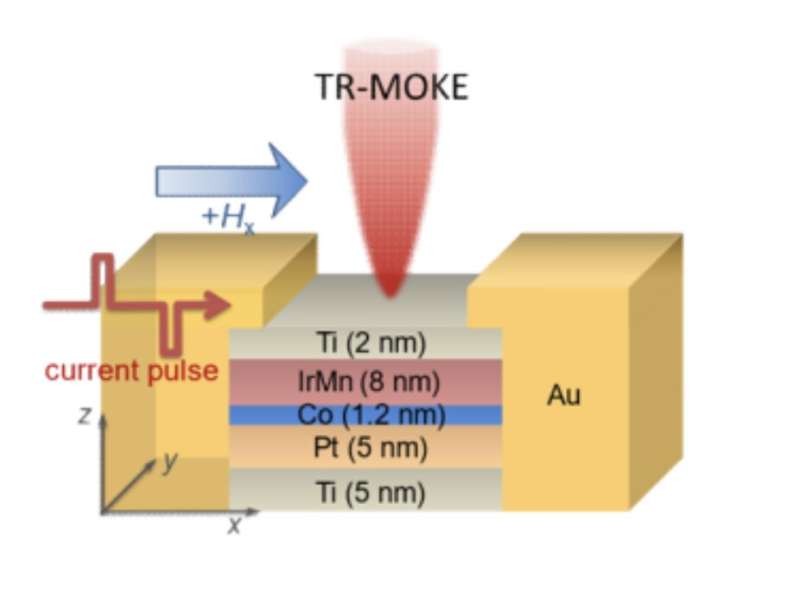December 20, 2022
feature

Magnetic random access memories (MRAMs), are among the most promising next-generation memory technologies. Their primary advantages over conventional computer memories and other emerging memory designs include their potential to achieve remarkably high speeds and their non-volatility.
To maximize the speed and performance of MRAMs, engineers need to be able to study their underlying mechanisms in great depth, particularly the switching trajectories in ferromagnet/antiferromagnet exchange-biased structures. So far, however, available methods to monitor these processes over time remain limited.
Researchers at Technical University of Munich and Tsinghua University have recently demonstrated the time-resolved detection of a spin-orbit torque switching of magnetization and exchange bias. The method they employed, outlined in Nature Electronics, is based on the use of advanced magnetic microscopy tools.
“To approach the highest possible writing speeds with MRAMs, in-depth knowledge concerning the magnetization switching process between ‘0’ and ‘1’ is indispensable,” Christian Back, one of the researchers who carried out the study, told TechXplore.
“However, the detection of magnetization switching has so far been limited to quasi-static experiments and nothing has been known concerning the timescales as well as the detailed writing process. Our group is specialized in time-resolved magnetic microscopy with high temporal resolution (1 picosecond temporal and about 300 nm spatial resolution), so it was natural for us to study such process in detail.”
The recent work by Back, Yuyan Wang and their colleagues builds on several previous studies, where they used time-resolved magnetic microscopy techniques to examine simpler structures. In their current study, they specifically used a stroboscopic pump-probe to monitor the switching trajectory of a magnetic element. This technique allowed them to record a “magnetic movie” of the switching process unfolding over time, with high temporal and spatial resolutions.
“In our case, the pump pulse is a current pulse sent through one of the layers of the prototype MRAM element and our probe pulse is a laser pulse that enables detection of the magnetic state,” Back explained. “We thus record switching trajectories or whole movies and compare them with realistic simulations of the whole magnetic element. This finally allows us to extract the relevant parameters for the switching process and allows us to make a firm statement on the switching process as a whole.”
By experimenting with the parameters of the current pulse they used, the researchers ultimately achieved multilevel switching of the magnetization and antiferromagnetic exchange bias on a sub-nanosecond timescale, two processes found to be linked with the formation of multiple domain structures at the antiferromagnetic interface. They also showed that the spin-orbit torque induced switching of exchange bias in their MRAM prototype could stabilize multi-level magnetization switching within the short current pulse, improving the device’s stability.
“We made significant progress concerning the investigation of spin dynamics of spin-orbit torque (SOT)-based memory devices with a time resolution much better than 100 ps,” Back said. “By adopting time-resolved magneto-optical Kerr microscopy, combined with micromagnetic simulations, the authors discovered a multi-level switching process of the magnetization and exchange bias in SOT devices on sub-nanosecond timescales.”
The findings gathered by Back, Wang and their colleagues highlight promising strategies that could allow engineers to flexibly control the key processes underpinning the functioning of MRAM devices, ultimately improving their stability. In the future, their work could pave the way towards the development of SOT-MRAM with multi-bits that can operate at increasingly faster speeds, which could be particularly promising for neuromorphic computing and in-memory-computing applications.
“We now plan to continue investigating the spin dynamics of the SOT-MRAM devices comprising new materials (e.g., 2D materials) and novel structures, to further improve their operation speed and reduce the power consumption,” Back added.
Yuyan Wang et al, Time-resolved detection of spin–orbit torque switching of magnetization and exchange bias, Nature Electronics (2022). DOI: 10.1038/s41928-022-00870-3
© 2022 Science X Network
Citation:
A strategy to monitor spin-orbit torque switching and exchange bias over time (2022, December 20)
retrieved 20 December 2022
from https://techxplore.com/news/2022-12-strategy-spin-orbit-torque-exchange-bias.html
This document is subject to copyright. Apart from any fair dealing for the purpose of private study or research, no
part may be reproduced without the written permission. The content is provided for information purposes only.
For all the latest Technology News Click Here
For the latest news and updates, follow us on Google News.

